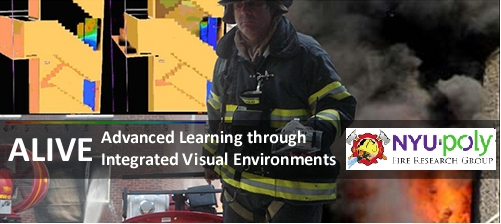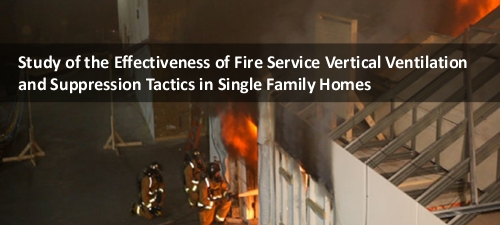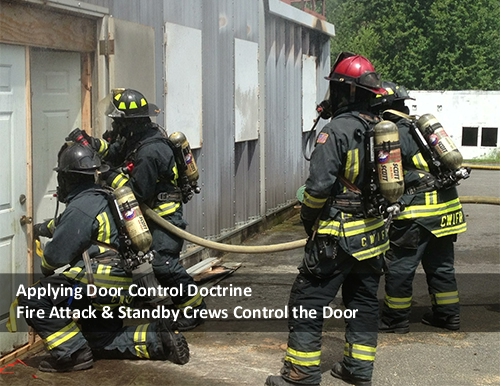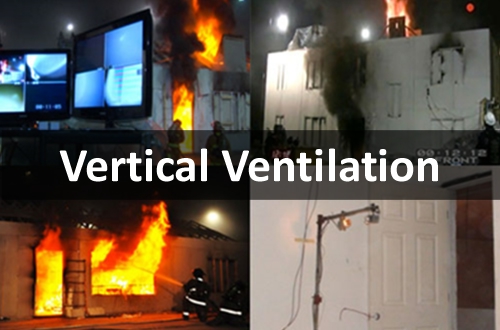The last several weeks have brought a number of interesting things in the area of fire dynamics and firefighting operations. Before getting back to the question of Door Control Doctrine, take a few minutes to have a look at the ALIVE on-line interactive training program by the NYU Poly Fire Research Group and the recently released research report Study of the Effectiveness of Fire Service Vertical Ventilation and Suppression Tactics in Single Family Homes
ALIVE On-Line Interactive Training
NYU Poly Fire Research Group has teamed up with the FDNY, Chicago Fire Department (CFD) the Bloomington Fire Department (BFD), the Eagan Fire Department (EFD), and the Eden Prairie Fire Department (EPFD) to develop a web-based, interactive firefighter training program – ALIVE (Advanced Learning through Integrated Visual Environments).

A recently released training module addresses the implications of fire dynamics and lightweight/engineered construction on firefighting operations in residential occupancies. Narrated by FDNY Lieutenant John Ceriello, this training program provides an excellent integrated review of current research conducted by UL, NIST, FDNY & the CFD and its application to fireground operations. The on-line training is available for use on a PC as well as an iOS and Android app. Have a look and share this important training with others!
UL Vertical Ventilation
Underwriters Laboratories Fire Service Research Institute (UL FSRI) recently released the research report Study of the Effectiveness of Fire Service Vertical Ventilation and Suppression Tactics in Single Family Homes.

In conjunction with with the previous study on horizontal ventilation, this report provides a solid look at the capabilities and limitations of tactical ventilation in a residential context. Download a copy of the report and review the tactical implications (or read the entire report if you are extremely ambitious). The outcomes of this research will be explored in detail in upcoming CFBT-US blog posts.
Visit the UL FSRI web site and Facebook Page for regular updates on UL’s ongoing research with the fire service!
Door Control Doctrine
Doctrine is a guide to action rather than a set of rigid rules. Clear and effective doctrine provides a common frame of reference, helps standardize operations, and improves readiness by establishing a common approach to tactics and tasks. Doctrine should link theory, history, experimentation, and practice to foster initiative and creative thinking.
Given what we know about the modern fire environment and the influence of both existing and increased ventilation on ventilation controlled fires, what guidance should we provide to firefighters regarding door control? The following questions are posed in the context of a residential occupancy (one or two-family home, garden apartment unit, townhouse, etc.).

If the door to the fire occupancy is open when the first company arrives, should it be (immediately) closed by the member performing the 360o reconnaissance? If so why? If not, why not?
In general, if the door is open it should be closed as soon as possible. In the modern fire environment, most fires beyond the incipient stage will be ventilation controlled when the first company arrives. Closing the door until the first line is ready to enter will limit air flow to the fire and reduce heat release rate.
If the door should be closed immediately there any circumstances under which it should not? If there are circumstances under which the door should not be closed, what are they and why?
If the fire is not ventilation controlled, closing the door will not have a positive impact. However, it is unlikely to have a negative effect as well. If occupants remain inside (or have gone back in through the open door in an effort to rescue others), an argument could be made that closing the door might make it more difficult for them to find the exit. However, under ventilation controlled conditions, the increased air supply will quickly make conditions untenable and the flow path between the open door and the fire will result in fire spread along this path, further reducing tenability and potential for safe occupant egress. The short answer is no. If the door is open, close it.
If the door is closed on arrival (or you closed the door during the 360o reconnaissance) when and how should it be opened for entry? Think about tactical size-up at the door, forcible entry requirements, and the actual process of opening the door and making entry? How might this differ based on conditions?
When the door is opened, the clock is ticking on increased heat release rate (HRR). The door should remain closed until a charged hoseline is in place and the crew on the hoseline is ready to make entry for fire attack.
The door entry procedure should include assessment of B-SAHF indicators and forcible entry requirements (if the door is closed and locked). If forcible entry is required, it may be forced before the crew is ready to enter, but should be controlled in a closed position after it is forced. The door may be opened briefly and partially to assess conditions and if necessary to cool the hot upper layer prior to entry, but should generally remain closed until the crew on the hoseline enters the building.
After making entry should the door be closed to the greatest extent possible (i.e., leaving room for the hoseline to pass)? If so why? If not, why not?
If the fire is shielded from direct attack from the door, it should be closed after entry to limit air flow to the fire and reduce the flow path between the entry point and the fire. Limiting air flow will slow the increase in HRR. Limiting the flow path (it cannot be eliminated by closing the door completely due to the space required to pass the hoseline) will reduce the risk of fire spread towards the entry point.
If the door should be closed to the greatest extent possible, who will maintain door control and aid in advancement of the line? How might this be accomplished with limited staffing?
This is a significant question! As always, it depends. With a four person crew, one member may control the door with a two person team working inside. With smaller crew sizes, the standby team (two-out) may be able to control the door. If operating with limited staffing (three) in rescue mode, the apparatus operator may need to add door control to their rather substantial list of critical tasks after charging the attack and standby lines).
If you are performing search, should doors to the rooms being searched be closed while searching? If so why? If not, why not? Are there conditions which would influence this decision? If so, what are they?
In the past, firefighters may have been trained to “vent as you go” when searching. The concept was that venting the rooms being searched would improve tenability and increase visibility. However, horizontal ventilation also creates a flow path between the fire and the ventilation opening. If the opening serves as an inlet (due to vertical position in relation to the fire or wind effects), it may improve conditions in the room, but has the potential to worsen fire conditions due to increased HRR. If the opening serves as an outlet, a flow path for fire spread is created, which will potentially worsen conditions in the room being searched.
Closing the door to the room being searched allows the searcher to tactically ventilate the room if necessary while preventing a flow path between the fire and the room being searched.
Should the doors to rooms which have been searched be closed after completing the primary search? If so why? If not, why not? Are there conditions which would influence this decision? If so, what are they?
As with closing the door, it depends. Tactical ventilation must be planned, systematic, and coordinated. If the fire is being controlled (water on the fire) and the location of the opening in the compartment which has been searched is advantageous and part of the ventilation plan, leaving the door open is necessary. If the location is not advantageous and part of the plan, it should be closed.
How else can doors be used to aid in fire control or the protection of occupants and firefighters? Give this some thought!
As seen in the UL horizontal and vertical ventilation research projects, a closed door provides an area of refuge for both building occupants and if necessary for firefighters. Be mindful of potential areas of refuge while working inside, particularly if you are not on a hoseline, or in the event that water supply in your hoseline is compromised.
LA County Fire Department adopts door control doctrine! In a recent video posted on the LA County Fire Department Training Division web site, Battalion Chief Derek Alkonis explains the department’s door control doctrine and how this integrates into residential fire attack with three and four person engine companies. While the use of straight streams in an effort to cool hot gases overhead differs considerably than the use of pulsed water fog advocated by CFBT-US, this video provides an excellent example of effective door control and integration of tactical anti-ventilation, fire control, and tactical ventilation.







